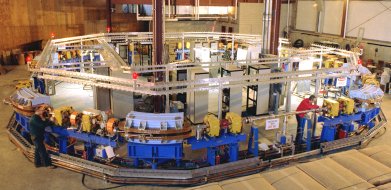Special relativity / Elementary Tour part 6: E=mc²
In special relativity, however, the inertial mass of a body directly depends on its speed – the higher the speed, the higher the mass. This effect is crucial for anyone operating a high-energy particle accelerator in which elementary particles are accelerated to speeds near that of light. The following image shows one such accelerator, the VUV ring at Brookhaven National Laboratory, with a circumference of 51 metres:

[© Courtesy of Brookhaven National Laboratory]
The relativistic increase of mass happens in a way that makes it impossible to accelerate an object to light speed: The faster the object already is, the more difficult any further acceleration becomes. The closer the object’s speed is to light speed, the greater the increase in inertial mass; to reach light speed exactly would require an infinitely strong force acting on the body. This enforces special relativity’s speed limit: No material object can be accelerated to light speed.
The increase in inertial mass is part of a more general phenomenon, the relativistic equivalence of mass and energy: If one adds energy to a body, one automatically increases its mass; if one takes energy away from it, one decreases its mass. In the case of acceleration, the object in question gains kinetic energy (“movement energy”), and this increase in energy automatically means an increase in mass.
On the other hand, even an object at rest turns out to have a certain amount of energy. Energy and (inertial) mass are inextricably linked by Einstein’s famous formula. Every body of mass m will necessarily have a total energy
E = mc²
(where the constant c is the speed of light). Inverting the formula, every body which has the total energy E will have an inertial mass m = E/c². Although physicists used to measure them in different units (which necessitate the conversion factor c²), mass and energy really are the same. The only reason pre-Einstein physicists defined them as separate concepts in the first place is because they didn’t yet know the whole picture.










